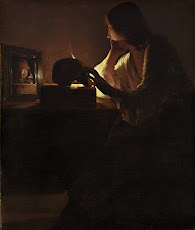The Company We Keep by Kristy Moreno
Use of Line
The pieces found in this exhibition explore the elements of art in many ways, drawing the eye in. Moreno uses line very boldly across these sculptures, drawing the viewers attention across the entire three dimensional sculpture in each. The repeating lines present in the hair of the depicted figures creates a satisfying pattern that replicates itself across the whole exhibition.
Use of Color
Beyond the strong use of line within this show, color is very prevalent across these pieces, using nontraditional methods of applying color in ceramics. The method used behind these pieces is the use of mason stains, mixing colorant with wet clay and applying it before firing, unlike most traditional ceramics that use glazes to create a bright, glossy finish. While the use of these mason stains does not yield as vibrant of colors, it can be seen that color was used liberally on these pieces, with contrast in these colors making elements like accessories very noticeable in form of earrings, glasses, and makeup.
Use of Shape and Space
Furthermore, the shape present in these figurative sculptures is a fascinating element, given that without the detail, the shapes of these sculptures hardly resemble anything of note. The added detail of these figures overlapping one another and filling the space creates a very condensed but yet comfortable sense, with connection from each figure to every other.
Presentation
The presentation and depiction of these sculptures from Moreno is key due to their three dimensional nature. As seen in this exhibition in the Ochi Gallery, The presentation is on pedestals, with viewers able to walk around it a take it in from every side. Pictures do not do this work justice and ideally it must be seen in person. This exhibition was created in Montana at the Archie Bray Foundation and presented in the Ochi Gallery in Los Angeles, California. The display was open January 6th - February 10th, 2024.
My Opinion
The work from Moreno is an in depth exploration in found community and self expression and she explores these topics by using the depiction of futuristic, expressive figures. This is heavily enhanced with the aforementioned use of the elements of art by bringing attention to the decorations of these characters. Beyond that the use of space truly brings the sculptures together, with the figures creating a community like closeness, almost like found family by overlapping and sharing the space upon these sculptures. The Company We Keep portrays the intended concepts very well with clever uses of shape and color to enhance the message and make the work very impactful.
Works Cited
“About.” KRISTY MORENO, kristymorenoart.weebly.com/about.html.







My thought exactly about the lines and hair! The hair is the first thing that grabbed my attention about the piece. One's hair would instantly draw me to the next, as if the lines connected each piece together. The method behind the color is fascinating; I would love to see more work using this coloring method. It makes me wonder why more artists don't use this method in their work. The colors produced are stunning shades, and truly make the accessories pop out. Your first comment about the shape brought out a laugh, for I couldn't help but envision the sculpture as a bare Mr. Potatohead. Without the detail they would be lifeless and disconnected. The piece as a whole beautifully displays close connection. Another element that drew me in was the over all visual texture of layers. The waves/knots in the hair, the details/designs on the clothes, and the clear transitions to each new detail, were all visually captivating and felt like you could run your fingers and experience them.
ReplyDelete